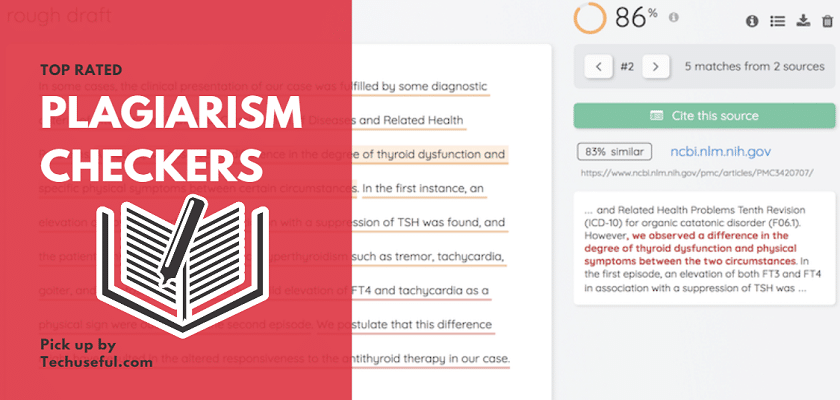
Have you ever used a line from a newspaper article or copied a sentence from Wikipedia?
Have you been submitting your elder sibling’s book reports as your own classroom assignments?
If you have answered “Yes” to the above questions, then you have plagiarized!
You may not find plagiarism to be a serious offence, probably which is why you have never hesitated in submitting a plagiarized assignment or using someone else’s work in your research without citing them as your reference. However, with the increasing laws surrounding plagiarized content, you may have to figure out new ways to get your paper or scripts accepted. You can even find free plagiarism checker for students, but first, let us start with the word, “PLAGIARISM”.
Top 7 Plagiarism Checkers For Everyone
Have you used Google to prepare your assignments and would like to run your script through a plagiarism checker online?
Have you hired a new native English writer recently and would like to check whether he / she is delivering unique and original content as promised, or is making a fool out of you?
Do you understand the importance of original and unique content in SEO?
When writing on your own, you are confident that you have crafted original content and cited the sources accurately. However, the situation is different if you are having a team of freelancers, geographically dispersed. If you ask yourself the above questions, you may be inclined to use a paper checker just to make sure that you are not involved in anything that may undermine your honesty and credibility on ground or online.
One last thing, before we move on to the reviews – There is no percentage of plagiarism that is acceptable professionally, however, most institutions advise to keep it as low as possible, preferably in the 10-15% range.
1Plagiarism Checker X
Plagiarism Checker X
It is considered one of the finest web plagiarism checkers by the online community to dig up traces of duplication. The software is popular for its speed, in-depth scanning, and accuracy. Countries around the world, including the top academic countries like USA, UK, Canada, and Germany, use Plagiarism Checker X. There are no word limits to check if you plagiarized. In addition to that, it offers several other options like checking word similarity, invalid spaces and case matching.
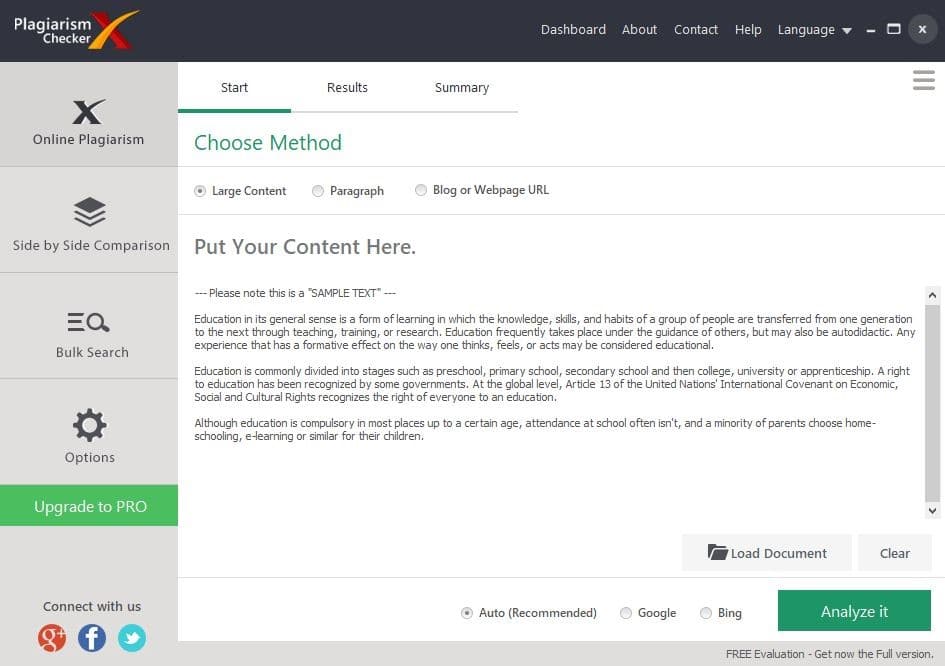
Other features include:
- Keyword Analyzer Tool
- Multi-Language Support
- Multiple File Scans – Side-by-Side
- Bulk-Cross Comparison
- Accurate & Instant Results
- 100% User Privacy
- Density-based, Color-Coded Results
- 24/7 Technical Support
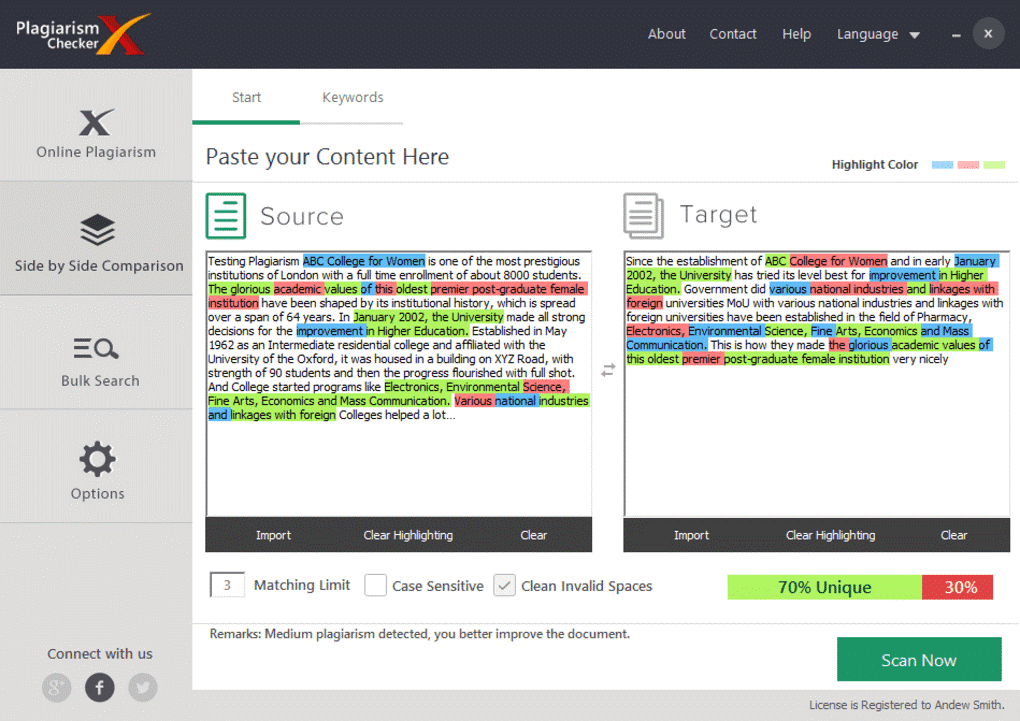
- It offers a user-friendly, convenient interface.
- You can check multiple files, side-by-side, for plagiarism between those files.
- Premium plan comes with unlimited words.
- The keyword analyzer tool displays occurrence & intensity of keywords instantly.
- Offers both, Paid & Free Versions
- You cannot use it without downloading the software.
All-in-all, Plagiarism Checker X is an amazing software that offers three plans. The basic plan offers free services for 14 days, and only 30 searches can be performed in a day, under a specified word limit. The Pro plan offers all features for a lifetime with just a small fee of $39.95. The Business plan is a multi-machine license that will cost you $147.95. It is also one of the best Turnitin alternatives.
2Grammarly
Grammarly
Grammarly has grown in popularity over the recent years and is one of the best duplicate content checkers in the market today. It is also ranked as one of the top proofreading tools with an advanced algorithm. It can identify over 400 grammatical errors.
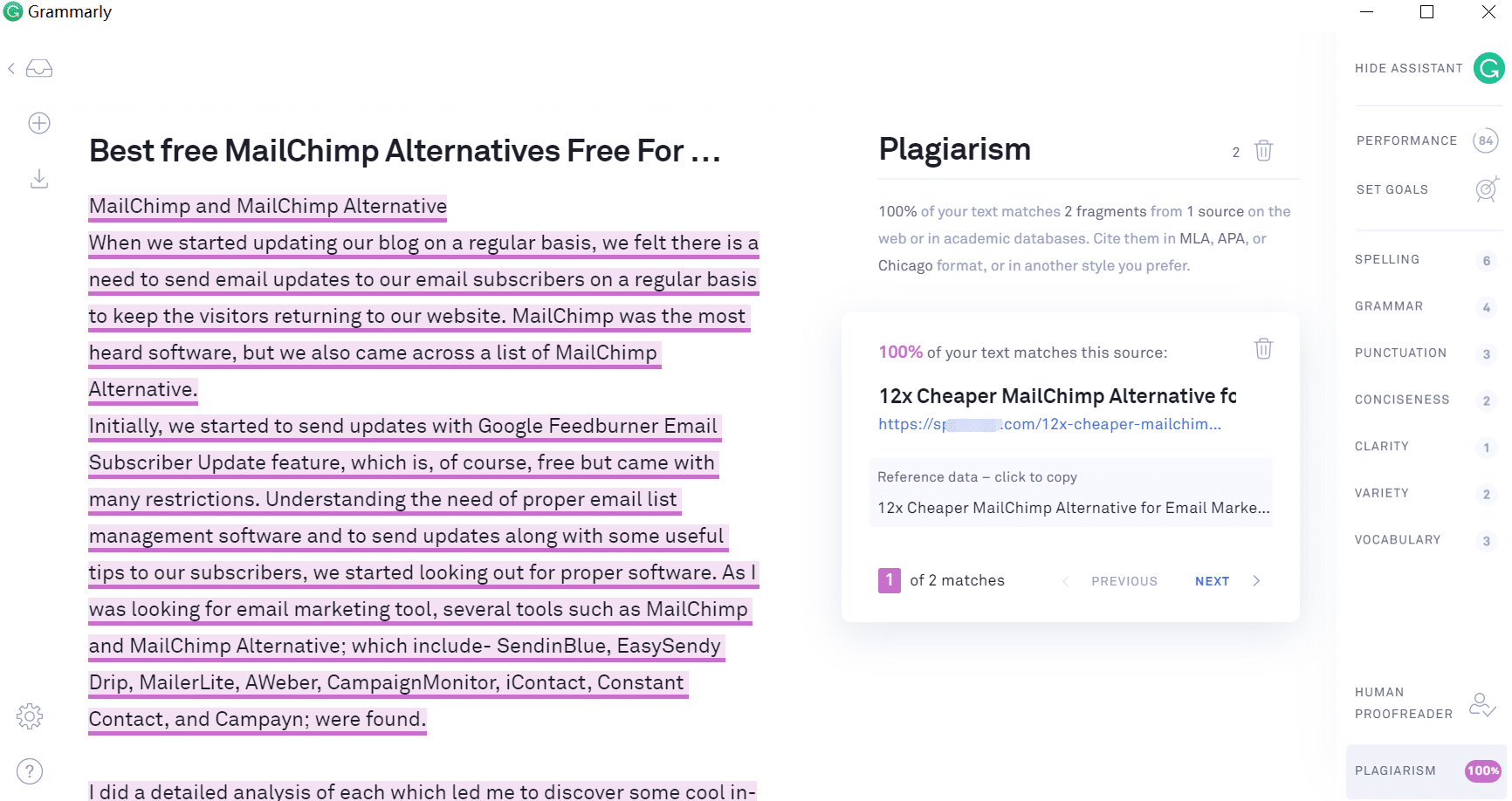
Moreover, it includes:
- Contextual Spelling Checker
- Vocabulary Enhancement
- Grammarly Native Apps
- Plagiarism Checker
- Summary & Detailed Reports
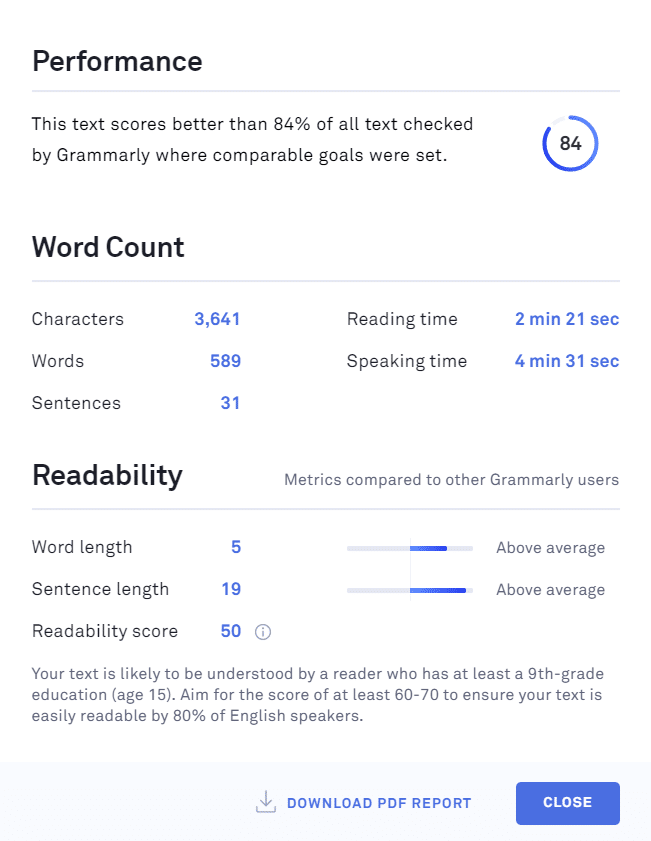
(Source: https://thehightechsociety.com/what-is-grammarly/)
- Flawless integration with Outlook, MS Office and web browsers
- You can verify your content from over 16 million websites.
- It helps eliminate sentence wordiness.
- A sophisticated, easy-to-navigate interface
- The online version only shows a summary report for grammatical mistakes when you paste your content.
- You cannot check work for plagiarism free
- Plagiarism cannot be checked using the website.
- It does not detect content duplication accurately, sometimes.
- It offers aggressive advertisements unless you upgrade to its premium plan.
Although Grammarly is advertised primarily as a grammar-checking tool, its capabilities as a plagiarizing checker cannot be undermined. You can use Grammarly for a small, monthly price of $11.66, that is, if you go for annual subscription. Month-to-month billing can cost you $29.95.
3Copyscape
Copyscape
Copyscape is also one of the top ranking site to check plagiarism free content, especially for bloggers. It offers simple operation where you just need to type in the URL and it will result in several web pages, depending on whether you have plagiarized or not. Clicking on the results will show highlighted sentences and phrases in that page.
The best thing about Copyscape is that you do not need to sign up. Just go to the website and paste the URL for instant results. However, a plagiarism report cannot be accessed in the free version.
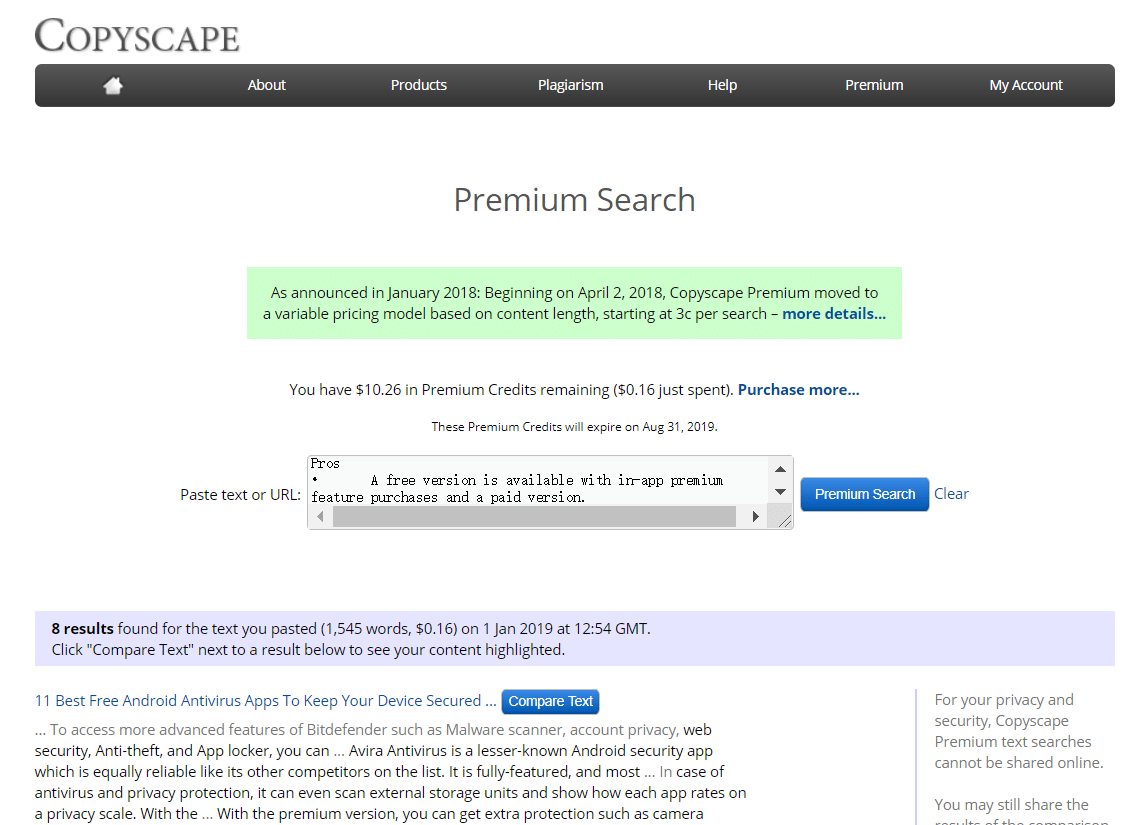
It also offers a free plagiarism tool where you can paste two URLs at a time or your text to find out the similarities in content. Other features include:
- Copyscape Premium – An even efficient version of the online plagiarism checker
- Copysentry – An automated alerts service that detects the web for your copied content
- A powerful tool for exact identification of content
- Ideal tool for blog owners etc.
- API integration for quick scanning
- Free warning banners informing about plagiarism
- You cannot scan offline text for free
- Credits need to be purchased, which can then be used to scan content.
- Complex purchase plan
Copysentry Standard offers weekly protection and costs $4.95 a month for 10 pages. If you want to scan additional pages, it costs $0.25 a month for every additional page. Copysentry Professional offers daily protection with prices – $19.95 a month for 10 pages, and $1.00 per month for every additional page. Copyscape Premium offers professional services at the rate of 3 cents per search, for 200 words, and an extra cent for every 100 words after the initial 200 limit.
4WhiteSmoke
WhiteSmoke
WhiteSmoke is an outstanding software that comes with numerous features, including a language translator. Its plagiarism detection tool is extremely easy to use, and can even be installed on your iOS / Android device. WhiteSmoke also offers an add-on for Microsoft Office to make integration easier.
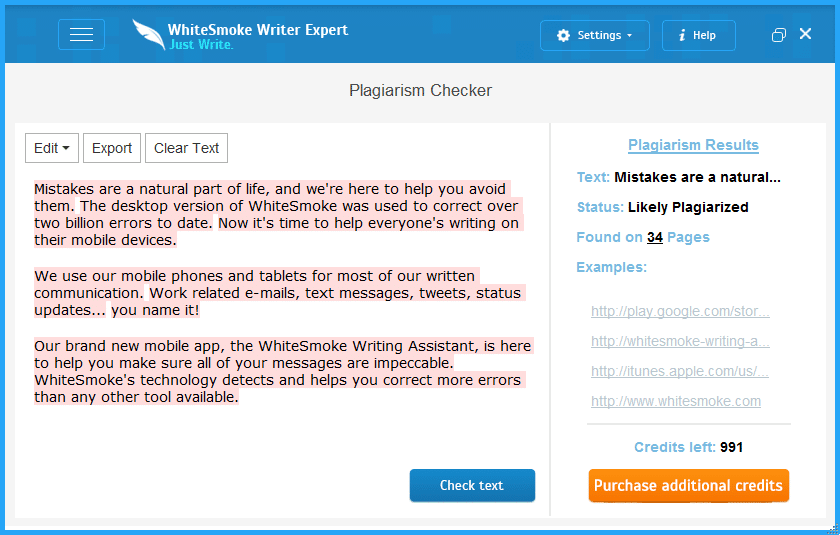
(Source: http://www.whitesmoke.com/whitesmoke_premium_trial_users)
It primarily offers the following:
- Grammar and Plagiarism Checker
- Spell Checker
- Punctuation Checker
- Style Checker
- Translator
- It is a cheaper option when compared to Grammarly
- Scans your documents with a thorough analysis
- Multiple platform support – Send 100% original emails
- Highly recommended for search papers
- It often provides inaccurate and wrong suggestions
- Comes next in line to Grammarly when considering database size
WhiteSmoke offers three plans: Essential, Premium and Mobile App. The Essential plan costs $9.95 a month while annual billing will cost you $79.95. The Premium plan costs $14.95 a month, or $119.95 annually. The mobile app can be purchased with both plans for a monthly fee of $2.50 or at an annual cost of $9.95.
5Plagium
Plagium
Plagium is another popular copy checker that offers two major options when you want to check your paper for plagiarism. The Quick Search option allows you to quickly scan the text for any major plagiarized content whereas the Deep Search option does a more thorough scan of the same text. Deep search requires you to sign up with a free account. You can even set a relevancy rate for measuring the level of plagiarism.
With a simple and straightforward interface, all you need to do is to paste your script and the results will appear in a few seconds. By clicking on any of the results, you can directly view the page and the sentences that have been duplicated. The “Batch Search” option allows checking of multiple URLs at a time. The plagiarism detection and checker tool can be used for free but uploading a file or scanning the content of a URL will require you to sign up.
Here is a screenshot of how Plagium works:
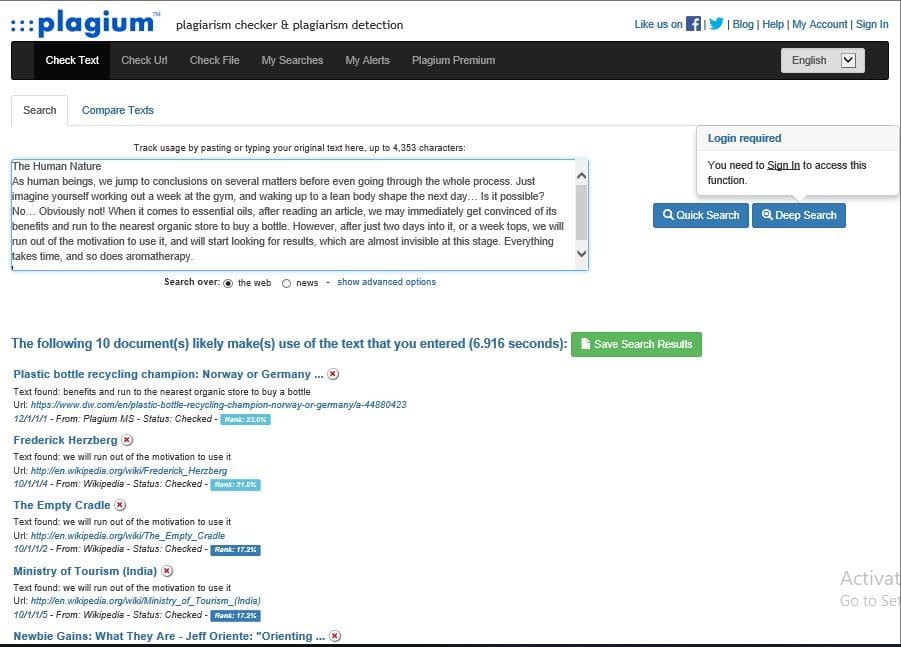
Plagium services include:
- Check if you have duplicated without the need for an account
- Set your preferred level of intensity for similarity
- Bulk scanning
- Very cheap packages
- Only 5000 words can be checked at once.
- Quick search does not offer detailed reports for plagiarism.
- Different rates for quick and in-depth search, as well as file scanning.
- No apps, add-ons, or browser extensions
- It often provides inaccurate and wrong suggestions
- Comes next in line to Grammarly when considering database size
The quick search costs 4 cents for every 1000 characters whereas deep search is double the rate for the same character count. URLs cost $0.08 per 1000 characters while scanning a file will only cost you $0.005 per 1000 characters.
How to Find the Best Content Checker?
Finding the best plagiarism software is not an easy task, but it is not impossible either. All you need to do is to do your homework and you will end up making the right choice. Here are a few factors you need to consider:
- Features
- User-Friendly Interface
- Simple & Color-Coded, Detailed Reports
- Translation (If your communication language is other than English)
- Pricing
- Plagiarism Apps
- After-Sales Support
An easier way is to search Google for comparison websites and compare the features of your top 3 or 5 choices. Including more options may not be a good idea since it will only confuse things.
What is Plagiarism?
Our teachers have constantly taught us to avoid copying the other students’ answers from our primary education phase. Plagiarism is basically the same.
By definition, “Plagiarism is presenting someone else’s work or ideas as your own, with or without their consent, by incorporating it into your work without full acknowledgement. All published and unpublished material, whether in manuscript, printed or electronic form, is covered under this definition. Plagiarism may be intentional or reckless, or unintentional. Under the regulations for examinations, intentional or reckless plagiarism is a disciplinary offence”, (@University of Oxford).
The Merriam-Webster dictionary explains plagiarism through the following phrases
- “To steal and pass off (the ideas or words of another) as one's own”
- “To use (another's production) without crediting the source”
- “To commit literary theft”
- “To present as new and original an idea or product derived from an existing source”
Therefore, any act of duplicating content, and not citing it properly, as well as lying about it constitutes as plagiarism.
(Source: https://www.plagiarism.org/article/what-is-plagiarism)
Types of Plagiarism
1. Verbatim Quotation (One form of Direct Plagiarism)
This is one of the most common types of plagiarism. When content is used word-to-word from a source, it should be written in inverted commas, with clear acknowledgement through complete citation of sources. It must be apparent to the readers throughout your script whether it includes your own work or someone else’s language. Failure to mention this constitutes as plagiarism.
The above definition of plagiarism is an accurate example of how duplicate content should be included in your own work.
2. Paraphrasing (Another form of Direct Plagiarism)
You are plagiarizing content if you are just altering a few words from an Internet or paper source, and changing the order to make it original. Not acknowledging the author in your work is another thing that you need to take care of to avoid plagiarizing.
3. Source-based Plagiarism
If you are attempting to pass copied content as your own, and mention non-existent or incorrect sources to make it appear real, it is referred to as misleading citation. Failing to mention the secondary source while drafting your content counts as plagiarism.
It also includes falsification and data fabrication. Making up of bogus data and findings, as well as creating a falsifying impression or omitting data constitutes as plagiarism. The consequences of this may be grave if the information relates to medical or scientific research as well as identity theft.
4. Inaccurate Authorship
An individual contributing his / her research and findings but not getting credit for his / her work is an act of plagiarism. Even if the situation is the other way around, i.e. if an individual is credited with a piece of work without contribution, it still comes under plagiarism. Inaccurate authorship is a serious violation of the code of conduct of research.
Editing someone else’s manuscript that results in substantive changes is also a violation. It is mandatory to acknowledge the editors before publication.
5. Auto or Self Plagiarism
This may be the simplest form of plagiarism, which is often not considered as one, since you are submitting your previous work in new classes without permission from your professors. Mixing parts of your previous work also counts as plagiarism. Simply put, it is the duplication of your historically published work without reference. This type of plagiarism is more commonly found in researches. Many research journals use online plagiarism checker with reports before reviewing them.
6. Mosaic Plagiarism
Mosaic plagiarism is when a student uses sentences from an online or paper source without quotations or uses synonyms of words in the original piece of content, ultimately maintaining the outlay. It is also referred to as “patch writing”. It may be intentional or accidental but is still punishable academically.
7. Accidental Plagiarism
This may sound similar to the other forms of plagiarism. When an individual neglects the sources of content or unintentionally misquotes or paraphrases a source without attribution, it is considered as plagiarism. Merely, the lack of intent does not dissolve an act of plagiarism.
Why is it Important to Understand Plagiarism?
How would you feel if someone stole your original work and published it on the Internet as their own? You’d feel frustrated… wouldn’t you?
Plagiarism is an ever-growing issue whether we talk about academics, research or online content. Integrity and intellectual honesty are very important when it comes to academics. Whether it is ideas, words or data, if it is copied from someone else, you have failed in your learning. It not only shows off your poor scholarship but dictates your commitment to your academics or job. This is the very reason plagiarism is considered unethical and can result in serious consequences in your future.
An institution issuing degrees over a student’s history of plagiarized assignments and reports undermines its own credibility. If caught, an institution may be blacklisted. A student of that institution, found in the act of plagiarism may also be blacklisted, and may not be able to continue further studies or get employed. Even though plagiarism is only considered an issue in academics, the intensity of the situation has spread across different sectors including corporate, journalism and politics.
Conclusion
Even if you have plagiarized in the past and got away with it, you are lucky to have a second chance and make things right. Considering the seriousness of the offence, it is better to be safe than sorry. You can even go for a premium plagiarism checker if you deal in bulk content on a daily basis. Choose the best plagiarism checker today and write your scripts in full confidence!





